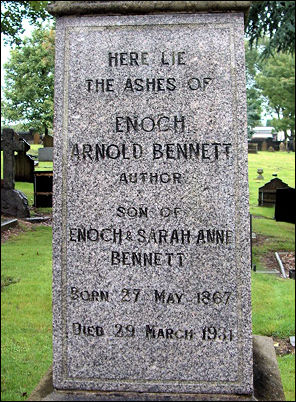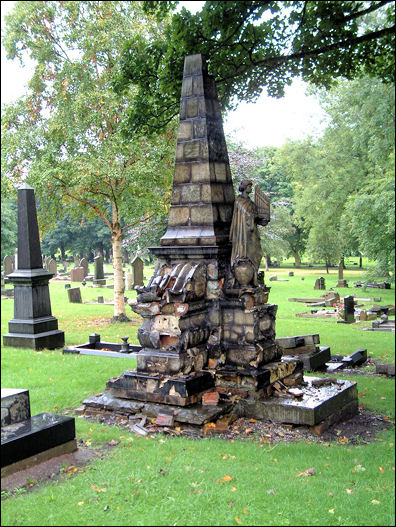|
the history of Burslem Cemetery
  
click the
"contents" button to get back to the main index & map
next: Longton Cemetery
previous: the monks and Rushton Grange
|
Historian Fred Hughes
writes....
I always have a laugh when I pass the grave of Arnold Bennett. And before
all you Bennett aficionados reach for your quills in order to stab my eyes
out, let me explain. Better still I’ll let the former chairman of the
Arnold Bennett Society, author John Potter, tell you.
“I guess what you’re referring to is the error over the date of his
death,” he says. “The only explanation I can give is that the handwriting
of whoever provided the information to the stonemason was so bad that the
last digit appeared as a 9 instead of 7. Unfortunately the information on
the only memorial to one of the world’s greatest novelists will forever
remain inaccurate.”
The great Potteries’ man of letters was born in Hanley on 27th
May 1867 and he died in London on 27th March 1931. So is there
a bigger story about how the stonemason carved the date of his death as
the 29th?

“There was quite a family tussle after Bennett died,” John explains.
“He and his wife Marguerite had been separated for many years but they
never divorced despite him having what we would call a common law
marriage with the actress Dorothy Cheston. You could say it was a family
at war; Dorothy wanted to keep the ashes in London while Marguerite and
the rest of the Bennetts wished to have the remains interred alongside
his mother at Burslem. In any event the ashes remained at Golders Green
Cemetery for four months before they were brought home. Perhaps the
mistake was made because of this time lapse.”

It’s a lovely story, one that Bennett could easily have written with his
proclivity for irony. Burslem Cemetery is full of such stories.
“Cemeteries were made for the local historian,”
says Steve Birks, himself the writer of one of the best history sites on
the web. “Burslem Cemetery is no exception; in fact it’s among the most
informative. The site in Nettlebank Smallthorne was opened in 1879 and
covers about 28 acres. It was intended to be a recreation park for
strolling about, and even riding and cycling. At least a third of the land
was used for the lodges along the walks. In fact only about five and a
half acres was specifically intended for burials. It was a pleasure park
as well as a place for memorials and reflection. And the centrepiece was
the chapel set in the middle.”
Burslem was an independent borough when the cemetery opened. It was
described in one journal as being one of the most beautiful in the
country.
|
“It cost £20,500 to create and was miles ahead of its time as a community
facility. The compact chapel was the focal point from which long avenues
of trees and flowering shrub radiated,” adds Steve.

The Chapel at Burslem
Cemetery
photo - September 2008 - just before demolition
The tall redbrick building with carved stone embellishments blends with
the mock-gothic windows. An eye-catching entrance holds a cluster of stone
buttresses and corbels surrounding a modest arched entrance above which is
a panel of decorative Minton tiles. Sadly the days of the chapel are
numbered as the council makes preparations to demolish it on grounds of
safety and maintenance.
Councillor Joan Bell, the city council's portfolio holder for community
safety and bereavement care tells me, “We have recently reviewed our
cemetery properties and decided that Burslem chapel is under-used and in
poor condition. It is estimated that it would cost £130,000 to repair and
considering we are short of burial space the demolition of the chapel is
appropriate.”
It’s a decision that puzzles Steve.
“It is an exceptional building that reflects its times,” he comments. “I
can’t see how so much money in restoration is justified. And the city must
be really short of burial space if it thinks that the release of such a
small mount of land will alleviate the situation.”
|
But facts have to be faced – Burslem cemetery was built for the Victorians
who celebrated death in ostentatious architectural fashion.
“The grave that fascinates me is the Thomas Hulme memorial that lies east
of the chapel,” says Steve. “It must have been a fantastic thing when it
was unveiled and people must have visited it for years just to gaze on its
amazing sculpture.”
Thomas Hulme was the perfect Victorian do-gooder. He owned a pottery and
was a leading proponent of the arts helping to fund the Wedgwood Institute
and provide the land and financial support to build Burslem’s School of
Art.

the memorial of Thomas
Hulme's grave - Burslem Cemetery
“The grave was a monument to art and a glorious tribute to Hulme,” says
Steve. “The whole was built from individually modelled panels of glazed
pot clay depicting all the projects he was involved in. It’s like reading
a picture book, a biography of a great man. Of course the material it is
constructed from couldn’t last. And now it has deteriorated to the extent
that it may be beyond saving.
Who has responsibility for maintaining these things? Perhaps the council
should review its responsibility to preserve works of art instead of
knocking them down or allowing them to decay beyond recovery.”
 More on Burslem
Cemetery
More on Burslem
Cemetery
|
![]()
![]()
![]()